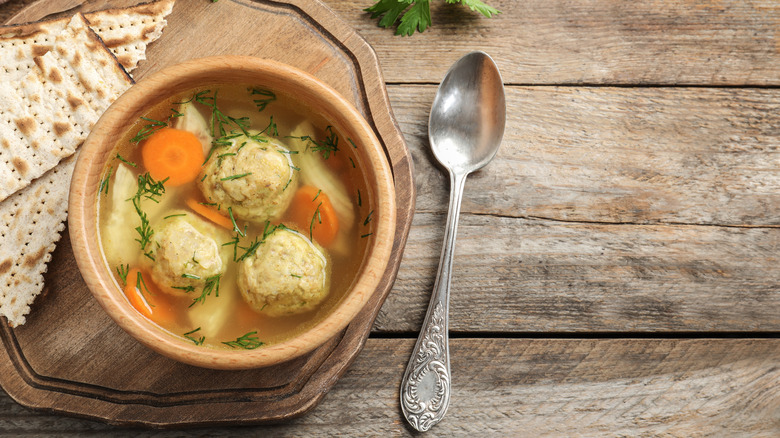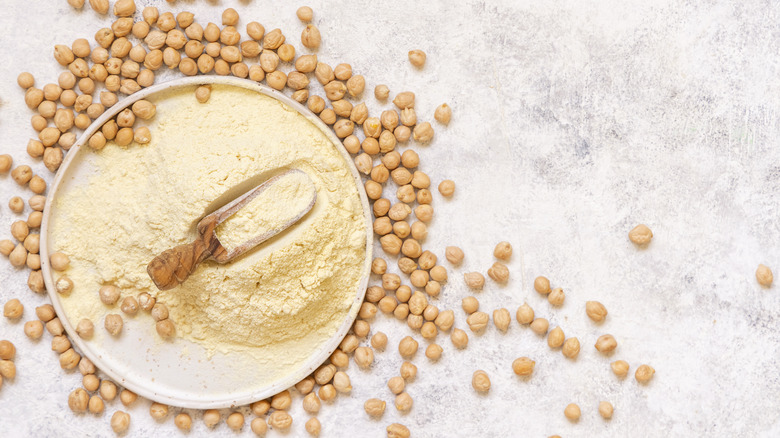Gondi: The Iranian Chicken Meatball Soup You Should Know
While Iran may not be on the top of everyone's travel list, we believe there are many reasons to change that. Whether you go for the incredible hospitality, to visit some of the 21 UNESCO world heritage sites, or to immerse yourself in the beautiful landscapes, Iran has something for everyone (Culture Trip). And, of course, the food is no exception.
Iran is a Persian country with a long history that's been impacted by many nations. From the Greeks to the Arabs to the Turks, Iranian food has been sculpted through centuries of varying cultural influence. Dishes like rice and tahdig — fluffy basmati rice with a crispy golden layer on top — and chelo kebabs are staples worth trying (via Wanderlust). Similarly, gondi is a staple dish in Iranian-Jewish households, but can be enjoyed by anyone. Gondi is a meatball soup, which is fitting, because meatballs might have originated from Persian cooking. It provides a fantastic introduction to Persian cuisine because of its use of chickpea flour and other traditional ingredients, per Eating Well.
History of gondi
According to The Taste of Jewish Culture, the Persian community is among the oldest communities of the Jewish diaspora. Their food is known for its incorporation of aromatic flavors and colorful ingredients. Their cuisine is not as popular in other communities, but Persian Jews enjoy many common Iranian dishes. The site explains that gondi is the pinnacle dish in Jewish-Persian cuisine, and is not commonly eaten by non-Jewish Persians. Gondi's origins aren't fully known as several cities in Iran claim to be its originator, but according to The Food Dictator, it usually traces back to Jews in Tehran.
Gondi is traditionally served on Shabbat in Jewish households. It can be made with beef, lamb, or veal, but chicken is most commonly used. Chicken was historically more expensive than other meat options. Since it was not eaten as regularly, saving chicken for Shabbat was traditional (via The Taste of Jewish Culture).
Ingredients in gondi
Gondi is full of hearty ingredients that mix well together. The taste of gondi is fresh and herby, while still being a fulfilling meal. The flavorful spices and fresh vegetables can be changed for preferences, but there are a few that typically make the list.
For the meatballs, chicken is usually the primary meat, and it is blended with chickpea flour. Chopped onions can optionally be added in for added acidity or flavor (via Eating Well). Seasonings like turmeric, cumin, and cardamom can be added to the mixture and will make the meatballs far more fragrant (via Serious Eats).
The broth is usually chicken as well, and veggies can be cooked in the liquid. Serious Eats uses carrots, leeks, celery, and potatoes, but these are optional. No veggies need to be added at all to have a balanced meal. Fresh parsley or other herbs on top are also an added bonus.
How gondi is made
Gondi is a soup dish that is relatively simple to make. When done right, the meatballs come out juicy and tender, and the broth is perfectly fragrant. Balancing all the flavor profiles can be tricky, but with practice it is achievable. It is also a great fill-in for matzo ball soup for Passover, according to Serious Eats.
According to Eating Well's recipe, preparation starts with the main attraction — the meatballs. To make them, chickpea flour is added to ground chicken in a bowl with warm water. Then, it's mixed by hand until the mixture is no longer sticky before rolling into balls and refrigerating.
While the meat cools in the refrigerator, chicken broth is added to water and brought to a boil. Once boiled, the mixture is to a simmer, and seasonings are added. Finally, the meatballs are added to boiling water until they're cooked through. It's ready to serve in no time. Each soup can be topped with herbs to freshen the flavor.



